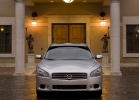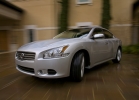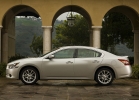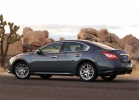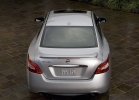Nissan Maxima test drive since 2009 sedan
Maximum options
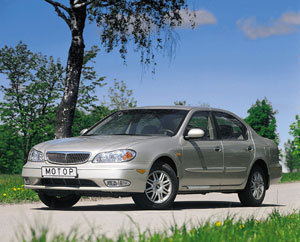 The Nissan Maxima sedan is well familiar to both American and European customers (we are not talking about Japan, there the car is sold like Nissan CEFIRO). Five years ago, the car entered the Russian market, and at the beginning of 2000 a new generation of Maxima appeared. And not one ...
The Nissan Maxima sedan is well familiar to both American and European customers (we are not talking about Japan, there the car is sold like Nissan CEFIRO). Five years ago, the car entered the Russian market, and at the beginning of 2000 a new generation of Maxima appeared. And not one ... Earlier than anyone, the Americans met the car - in the USA, Maxima went on sale twenty years ago (1981 model). The word maxima was not at first the name of the model, but meant only the highest package of the very popular Datsun 810 sedan at that time. The car received its own name Maxima a year later, and in 1984, the Datsun brand was replaced by Nissan Mark ...
In the fall of 1984 (1985 model year), the next generation of the car saw the light - the front -wheel drive and the V -shaped six instead of in -line. The third generation of Maxima was represented in 1989. The car did not shame the reputation won by its predecessors - formally referring to the category of family sedans, the car showed a completely sports character.
In 1994, a car on a new platform was born - the fourth generation of Maxima (1995 model year). The radically new VQ30DE engine developed 190 hp, the company filed the rear suspension of the Multi-Link Beam as something revolutionary. (It is difficult to agree with the latter: replacing an independent suspension with a curled beam, albeit with the mechanism of Scott -Rassel, is unlikely to improve the control of the machine. But you can understand - the company already had financial problems at that time, and such a revolution reduced cost.) In June, in June. 1994 in the United States sold a millionth Nissan Maxima sedan.
The fourth generation lasted six years on the conveyor (in 1997 they held a slight facelift), in February 2000, the fifth generation was shown to the American public.
A month later, the Maxima QX sedan debuted in Geneva, the second generation, the most prestigious car from the European Gamma Nissan (company press release). In the USA - the fifth, and in Europe - only the second? That's right, we are talking about a car with QX letters in the name, it really appeared only in 1995, before it (since 1987) the car was sold in Europe as just Maxima. Before that (since 1984) there was a model Nissan Bluebird Maxima ...
And there is a Nissan CEFIRO for the Japanese market, and Infiniti i30 - for American, and all this is essentially the same car that is assembled in Japan in different hypostles and sent to all ends of the world.
Why are all these details? The fact is that the machine that we got to the test was externally different from the American, and - slightly - from the European versions. What's this? The model year is correct, two thousandth. Japanese assembly. Lighting technology - it is easiest to determine the belonging of the machine - European, but the radiator grill - no, it is very similar to the lattice from Infiniti i30. The name on the lid of the trunk is maxima, without letters Qx. A speedometer - in kilometers. Apparently, the car was originally intended for some narrow market ...
So, Nissan Maxima is almost European performance. A middle class sedan with a three-liter V-shaped six under the hood. Strict smooth forms, successful proportions and a minimum of jewelry are solid. A pleasant impression is made by surprisingly even joints of body panels and the thoroughness of the finish.
The machine increased in size (plus 150 mm in length, 10 mm in width and 20 mm in height) - this can be seen with the naked eye. New headlights and a back lighting technique, a different radiator grille appeared (pay attention to how much they vary depending on the version of the machine), triangular cataphs on the side parts of the bumper. The wheelbase is extended by 50 mm, and the hardness of the body is increased by a third.
The front suspension remained the same (Macpherson on the subframe), only a slightly changed setting. There are changes in the back. This is still a patented torsion transverse beam Multi-Link Beam with the Scott-Rassel mechanism instead of a more traditional Panar thrust. But the mechanism, previously located in front of the beam, moved back - this should improve the clutch of tires with expensive, exchange rate stability and reduce body rolls. An additional effect is a decrease in the noise level in the cabin.
Now - about the power unit. The authoritative American magazine Ward's Auto World annually selects the ten best automobile engines - the VQ30DE motor has been included in it for six years in a row. For the new Maxima QX, it was slightly modernized (two -liter V6 remained unchanged) - mainly the inlet system and the gas distribution mechanism. As a result, the power increased from 193 to 200 hp, and the torque - from 255 to 271 nm. (For the Americans tried stronger - the exhaust system was also modernized. In the muffler Maxima, the design of which was borrowed from the Nissan Skyline GT -R model, the bypass valve appeared when the engine is transplanted over 2000. At the same time, the production path resistance is reduced and the power rises - before 222 hp)
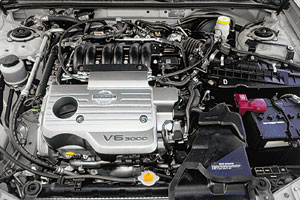 In order to reduce noise and vibrations, the engine is suspended on hydraulic supports, in the top versions of the car equipped with an automatic box, and the support of active - with electronic control. The five -speed mechanical gearbox did not undergo changes, in a four -speed assault rifle, the hydrotransformer has been modernized - this should increase the efficiency of the machine.
In order to reduce noise and vibrations, the engine is suspended on hydraulic supports, in the top versions of the car equipped with an automatic box, and the support of active - with electronic control. The five -speed mechanical gearbox did not undergo changes, in a four -speed assault rifle, the hydrotransformer has been modernized - this should increase the efficiency of the machine. The cabin became more spacious, especially in the area of \u200b\u200bthe legs - both behind and in front. The places above the head are enough for both front and rear riders. The back there are three three -point seat belts and three headrests, however, in the absence of the third passenger, the middle armrest can be lowered.
In the trunk (its volume has grown from 440 to 520 l) there are various mounts for cargo and mesh. A hatch locked in the back of the rear seat allows you to transport skiing.
The interior decoration is made of soft gray plastic of various shades with inserts - textile and under a tree. The seats are upholstered with fabric (leather sheathing - option). The size of the seats has increased, support improved. The pillows are located slightly higher than in the previous model - visibility has improved. Glazing has become thicker, it increased noise protection.
Electroregulations of the driver's seat allow not only to tilt the back and lift the pillow, but also to change the angle of installation of the latter.
On the door armor of the driver, the windows buttons, glass locks and doors are located. Under the armrest (you don’t notice at once) - the trunk buttons and the gas tank hatch. Chrome -made handles give the exterior a well -known fraction of exclusivity. At the same time, it cuts the eye how the ignition lock is solved - without any framing, naked metal sticks through the hole in the plastic.
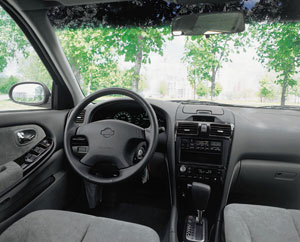 The steering column is adjustable along the angle of inclination, but not in length - it is surprising for the car, which is supplied in Europe as a business class car. The steering wheel is profiled under the fingers and sheathed with the skin, there are buttons of control of the radio. A device with fluorescent backlight is clearly visible through the steering wheel. The tachometer dominates (red zone - from 6600 to 8000 rpm) and a speedometer with a digital odometer. Under the console’s console is a radio tape recorder - not the most serious apparatus, but more worthy will easily stand in its place (and if you remove the box located below for different little things - even more worthy).
The steering column is adjustable along the angle of inclination, but not in length - it is surprising for the car, which is supplied in Europe as a business class car. The steering wheel is profiled under the fingers and sheathed with the skin, there are buttons of control of the radio. A device with fluorescent backlight is clearly visible through the steering wheel. The tachometer dominates (red zone - from 6600 to 8000 rpm) and a speedometer with a digital odometer. Under the console’s console is a radio tape recorder - not the most serious apparatus, but more worthy will easily stand in its place (and if you remove the box located below for different little things - even more worthy). The overall impression of the cabin is sitting like a glove, but does not cause claustrophobia, like some others, decorated in a cockpit style ...
The engine is good. Its acceptance in combination with the clear operation of the automatic box allows Maxima to easily become the leader of the traffic flow. The motor reactions to the gas pedal are instant and linear at any speed. At the same time, noise and vibration insulation are such that the engine is practically not heard.
The ergonomics of the driver’s place have been well worked out, all devices and controls are on the spot. But the ideal must be unattainable: the left leg was numb, the stand for it is too shifted to the right, and you have to sit, bending the limb in the most successful way.
The steering wheel is convenient, the hands do not slip, the feedback is felt well, although you can’t call sharp control. The car is best behaved when moving in a straight line at high speed - this is a car for German autobahns or American highways. At the same time, the suspension swallows even large bumps perfectly. Sitting at the back shakes a little more energetically. But it is much more important that the wheels do not lose contact with the road.
There are no term stability against direct claims. The behavior in corners is front -wheel drive and quite predictable, the cranes of the body are minimal. The fact that the back is not an independent suspension, but the beam can only feel a very experienced driver, and even then on an uneven road. A feature of the car - the driver does not feel the real speed: on the speedometer - 130 km/h, and in the sensations - about 60.
Brakes are perfectly working: equipped with an ABS, mechanical system Break Assist and an electronic brake forces distributor, they stop the machine so confidently that you might think that they were designed for a sports car ...
The modernization undoubtedly benefited the car. The car is perfectly balanced in every way. And the fact that outwardly he is not very striking is more a plus for many categories of customers than a minus.
Text: Alexey Ignatov
Source: Motor magazine [No. 7/2000]

